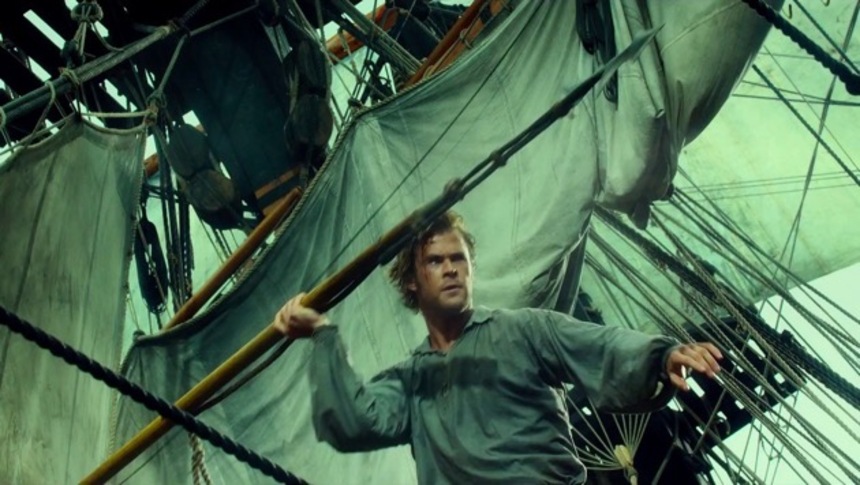Review: IN THE HEART OF THE SEA, Old-Fashioned In The Best Possible Way

Billed as the story that inspired Moby Dick, Ron Howard's adaptation of Nathaniel Philbrick's National Book Award winner is a shamelessly old-fashioned sea-faring yarn recounting the true story of the Essex, a Nantucket whaleship that sank after being attacked by a giant sperm whale.
Told in extensive flashback by Thomas Nickerson (Brendan Gleeson), at the insistence of writer Herman Melville (Ben Whishaw), who is researching his as-yet unwritten masterpiece, In The Heart of the Sea mostly takes place in 1820, as the whaleship Essex leaves Nantucket, Massachusetts under the command of Captain George Pollard (Benjamin Walker).
The inexperienced skipper is instantly at loggerheads with his first mate, Owen Chase (Chris Hemsworth), who has sailed for years and believes he should be in charge. Among their crew are also Owen's friend Matthew Joy (Cillian Murphy), Pollard's cousin Coffin (Frank Dillane) and green horn cabin boy, Thomas, played as a young lad by Tom Holland.
On-board rivalries are exacerbated as the Essex struggles to find its quarry and fill its promised quota of 2000 barrels of whale oil. But when they hear of schools of the giant mammals out in the middle of the Pacific, the Essex ventures off course, only to be confronted by a great white beast that proves inexplicably antagonistic towards the ship and its crew.
While not an adaptation of Melville's classic novel, In The Heart Of The Sea goes to similarly great lengths to submerge its audience in the specifics and intricacies of nineteenth century seamanship and whaling. From rigging sails to detailing how a whale carcass is dismantled and reduced to oil while still at sea, Howard and scriptwriter Charles Leavitt show us in painstaking detail. One particular sequence, in which young Thomas descends literally into the belly of the beast, is nauseating and compelling in equal measure.
This attention to authenticity extends to the actors themselves, who were put on a crippling diet of just 500 calories a day to shed the pounds necessary to portray the crew's lengthy ordeal at sea. Hemsworth, for example, reportedly lost 33lbs in just four weeks - all of which had to be carried out while filming continued in order for the effect to appear gradual.
Much of the film was shot at Leavesden Studios using blue screens, and the effect varies wildly from scene to scene. Numerous computer-generated vistas help convey Massachusetts in the film's opening sequences, and never quite ring true. Likewise, some ocean-bound scenes more closely resemble an oil painting that might adorn a paperback copy of Melville's novel than fully achieve photo-realistic clarity. While clearly a deliberate stylistic choice, considering the colour schemes and lighting patterns applied, the result is occasionally disorientating and disengaging.
At other times, however, Anthony Dod Mantle's cinematography is positively breathtaking. Sequences on a deserted island, the Essex's numerous encounters with the giant whale, and in particular the pivotal moment when the burning vessel succumbs to the salty depths, all look spectacular. In fact, visually the film is eerily reminiscent of John Huston's effective, yet admittedly now a little creaky 1956 film of Moby Dick, starring Gregory Peck.
Beyond their incredible physical transformations, the performances are uniformly strong without ever resorting to grandstanding. Hemsworth absolutely looks the part as non-nonsense leader and reluctant hero Chase, while Benjamin Walker (best known as Abraham Lincoln: Vampire Hunter) strikes a delicate balance with Pollard between spoilt brat and loathsome incompetent. Brendan Gleeson does a great job as the older Nickerson, whose dictation becomes increasingly confessional as the film progresses, while Tom Holland is perfectly fine as his younger incarnation. Sadly, Ben Whishaw and Cillian Murphy have little to work with in their respective roles, while the film's women - namely Michelle Fairley and Charlotte Riley - are leaning posts for their men and nothing more.
Despite these minor reservations, the result is a robust and sturdy high-seas adventure, knowingly reverential of both Melville's story and the age-old tradition of sailors' yarns of this nature that would regularly take on mythic proportions. Other cinematic works are evoked and alluded to throughout, from obvious touchpoints like Jaws and Titanic to Alive and Peter Weir's woefully underseen Master And Commander: The Far Side Of The World.
While the film's bold, at times expressionistic visual style might prove too much for some, there is a wonderfully old-fashioned air to Howard's film - akin to Spielberg's own Bridge Of Spies, albeit in a very different way - that recalls a Hollywood, and storytelling culture, of yesteryear that could certainly stand to be remembered. And if In The Heart Of The Sea inspires just one person to tackle Melville's Great American Novel, then the whole endeavour can be declared a worthwhile venture.
In the Heart of the Sea
Director(s)
- Ron Howard
Writer(s)
- Charles Leavitt (screenplay)
- Charles Leavitt (story)
- Rick Jaffa (story)
- Amanda Silver (story)
- Nathaniel Philbrick (book)
Cast
- Chris Hemsworth
- Benjamin Walker
- Cillian Murphy
- Brendan Gleeson

Do you feel this content is inappropriate or infringes upon your rights? Click here to report it, or see our DMCA policy.






